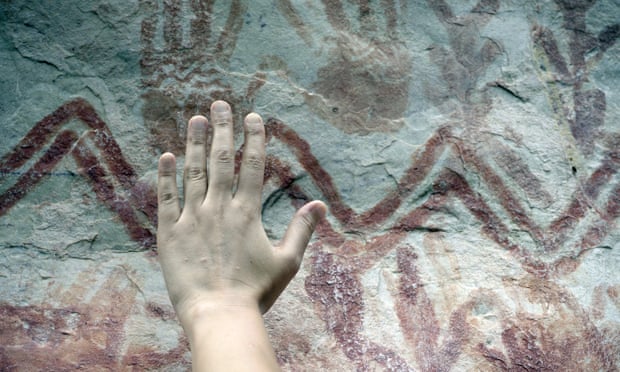Historical Item
12,500 year old rock art discovered in Amazonian rainforest
 'Sistine Chapel of the ancients' rock art discovered in remote Amazon forest
'Sistine Chapel of the ancients' rock art discovered in remote Amazon forest
Tens of thousands of ice age paintings across a cliff face shed light on people and animals from 12,500 years ago
Dalya Alberge, The Guardian (LINK)
Sun 29 Nov 2020 10.00 GMT
Photo: Marie-Claire Thomas/Wild Blue Media
One of the world’s largest collections of prehistoric rock art has been discovered in the Amazonian rainforest.
Hailed as “the Sistine Chapel of the ancients”, archaeologists have found tens of thousands of paintings of animals and humans created up to 12,500 years ago…
Read moreHistorical Graffiti Anti-Evil Spells

Medieval Graffiti to Repel Witches and Evil Spirits Found In Britain
21 OCTOBER, 2020 - 17:52 ED WHELAN
LINK
In Britain, a mysterious discovery has been made in the ruins of a church in an abandoned medieval village. On some stones, archaeologists have found graffiti and some enigmatic marking. It is believed that the markings were made to ward off evil spirits or witches. This discovery is a timely one as we approach Halloween.
Currently, there is a major infrastructure project being carried out in Stoke Mandeville, Buckinghamshire, England. It involves the construction of rail lines and a highway. This project will totally destroy a long-abandoned…
Read moreMinimal Man Stencils in Early-80s San Francisco
Echoes Are All I See
By marcella faustini, for Art Practical
September 10, 2015
“No one lives but me, shadows are my only friends, and ghosts are all I see.”
—Minimal Man, “Loneliness,” from The Shroud Of, 1981.
Despite the gentrifying pressure of high real-estate prices, the history of San Francisco’s underground culture and some of its notorious characters still haunts the city. Such is the case with Minimal Man, an early ’80s band fronted by Patrick Miller. The band, with a blend of post-punk, noise, and industrial music, produced six albums and numerous singles with a rotating cast of members. Although its output remains semi-obscure, the band has a cult following among enthusiasts of genre-bending music. Great interest is…
Read more1,400 Year Old Graffiti Found in UK
 Britain’s Oldest Example of Christian Graffiti Found Near Hadrian’s Wall
Britain’s Oldest Example of Christian Graffiti Found Near Hadrian’s Wall
By Alex Fox
SMITHSONIANMAG.COM
SEPTEMBER 1, 2020 11:45AM
Some 1,400 years ago, individuals living near Vindolanda, a Roman fort in northern England, inscribed a lead chalice with images of crosses, angels and other Christian symbols. Now, reports Dalya Alberge for the Guardian, archaeologists say that this vessel—unearthed during excavation of a ruined sixth-century church—represents the oldest known example of Christian graffiti ever found in Britain.
Recovered in 14 fragments, the chalice was once the size of a cereal bowl. Inscriptions…
Read moreMiniature Stenciled Art Rock found in AU
Rare Form of Miniature Stenciled Rock Art Found in Australia
New research suggests the small-scale illustrations may have been made with beeswax
By Alex Fox
SMITHSONIANMAG.COM
MAY 27, 2020
In 2017, researchers surveying the Yilbilinji rock shelter in northern Australia’s Limmen National Park discovered rare examples of miniature stenciled rock art. Now, a new study published in the journal Antiquity may unravel the…
Chilean Public Art Steps Up in Time of Revolution
The Writings on the City’s Walls: Street Art and Graffiti in Santiago, Chile in a Time of Social Revolution
FEBRUARY 17, 2020
Reporting: Street Art NYC (LINK)
The following post is by Houda Lazrak:
While visiting Santiago, Chile in late December, I sat down with Santiago-based architect and street art/graffiti expert Sebastián Cuevas Vergara. We met a few blocks from one of Santiago’s main urban landmarks, Plaza Baquedano, now known as Plaza de la Dignidad or Dignity Square — the main site of Chile’s protests against social inequality that erupted last October following a hike in subway fares.
Every Friday afternoon, thousands gather in Plaza de la Dignidad to express their frustration with the high cost of living, rising rents, government corruption and an…
Read moreBanksy Collaborator Steve Lazarides Tells (Almost) All

'We were lawless!' Banksy's photographer reveals their scams and scrapes
Steve Lazarides was the art renegade’s strategist, photographer and minder. As his shots are published [in a self-published book], he recalls the politics, parties and soaring price tags of ‘Matey Boy’
Stuart Jeffries (The Guardian)
Mon 16 Dec 2019 12.54 GMTLast modified on Mon 16 Dec 2019 16.50 GMT
One Christmas, Steve Lazarides and Banksy [his Stencil Archive] decided to kill Santa. “Reject false…
A Lesson in Street Art, Part I
A Lesson in Street Art: how a movement morphed out of graffiti and into the art world (Part I)
By Katherine Keener Published on 9 December 2019 (art-critique.com)
PURPOSE OF THIS LESSON:
Street art is a relatively new movement that is becoming more and more prolific in the art world. In this lesson, we will explore the history of graffiti, which is what street art is born out of, and then explore how street art has become what it is today. Looking at the history of graffiti is critical to understand the nuances of graffiti vs. street art and to understanding the pros and cons of street art as a movement and how artists categorized as street artists have either embraced or responded to the movement. At the end of the lesson, students should have a better understanding of how graffiti paved the way for street art. They should also be able to think critically about…
44,000 Year Old Cave Art, Including Hand Stencil, in Indonesia
Earliest known cave art by modern humans found in Indonesia
Pictures of human-like hunters and fleeing mammals dated to nearly 44,000 years old
Hannah Devlin (LINK)
Wed 11 Dec 2019 18.00 GMTLast modified on Wed 11 Dec 2019 18.12 GMT
Cave art depicting human-animal hybrid figures hunting warty pigs and dwarf buffaloes has been dated to nearly 44,000 years old, making it the earliest known cave art by our species.
The artwork in Indonesia is nearly twice as old as any previous hunting scene and provides unprecedented insights into the earliest storytelling and the emergence of modern human cognition.
Previously, images of this level of sophistication dated to about 20,000 years ago, with the oldest cave paintings believed to be more basic creations such as handprints.
“We…
Read moreExcerpts from The Nature of Paleolithic Art (2005)
 The Nature of Paleolithic Art by R. Dale Guthrie (2005, The University of Chicago Press). (Photo shows Paleolithic hand stencils from El Castillo, Spain)
The Nature of Paleolithic Art by R. Dale Guthrie (2005, The University of Chicago Press). (Photo shows Paleolithic hand stencils from El Castillo, Spain)
Art behavior evolved for creativity, the same way that lungs evolved for breathing. (p. 391) Creativity is something more than just doing things differently or unconstrained novelty. It is about beautiful alternatives within apt constraints. (p. 397) I suspect much of it [cave art] was done at a time in life when creative play provided the most fun. So calling it “art for art’s sake” may not be quite accurate. (p. 399) Paleolithic art certainly appears to me to be less “meaning-full,” less belief bound, and more a matter of individual perception and experiment. (p. 433) Paleolithic art is a silent touch from…
Read more